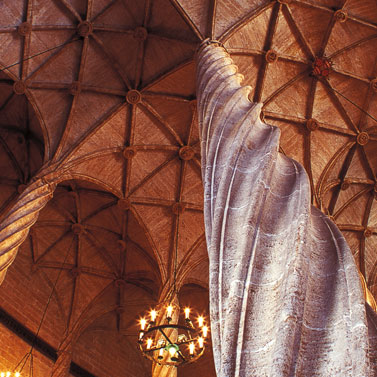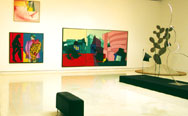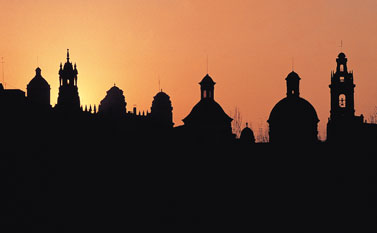- Villa search

- Canaries
- Caribbean
- Croatia, Bulgaria and Hungary
- Cyprus
- Florida
- France and Corsica
- Greece
- Italy
- Lakes and Mountains
- Madeira
- Malta and Gozo
- Portugal
- South Africa
- Spain - Balearics
More Information

The gothic interior of La Lonja
The historic centre of the city is pear-shaped, with the cathedral more or less in the centre. Immediately north of the cathedral, La Lonja is a splendid late gothic silk traders’ guildhall, adorned with ferocious-looking gargoyles, saints, and mythical creatures. Near the narrow end of the pear, the twin towers of the Torres de Serranos gateway are all that remain of the mediaeval city ramparts.
For art lovers, Valencia has two outstanding galleries (and a host of smaller ones). The Museo de Bellas Artes, at Palacio San Pio V, is the more predictable of the two with more than 1000 pieces of Roman statuary, old masters and all the rest. Don’t fail to see the paintings by Bosch and El Greco on the first floor, and the even more must-see Goyas on the top floor.
Less predictable – and more challenging – is the Instituto Valenciano de Arte Moderno, with a permanent collection of works by the Spanish modernist Julio Gonzalez (a local lad) and a mission to research and promote the art of the 20th century.
'A cynic might say that the Valencians have tried, and succeeded, to do what the ill-fated Millennium Dome so signally failed to achieve'
Valencia’s hinterland is the Huerta, a wide flood plain covered with the orange-groves for which the region has been famed for centuries and a patchwork of lush fields of tomatoes, avocados, artichokes, melons and squashes.
Much of this bounty is trucked to supermarkets across Europe, but the seasonal best and freshest gets no further than the Mercado Central on Plaza del Mercado 6.
Housed in a complex of cavernous Art Nouveau halls, this is one of the largest covered markets in Europe, and villa-dwellers with a fridge to stock need no further reason for a visit to Valencia. Like all such markets, it’s at its best first thing in the morning (open 08.00-15.00 daily except Sunday) for seafood, sausages and hams, meat and poultry, fruit and vegetables and market cafés where nobody bats an eyelid if you order a large brandy to go with your morning coffee.

Instituto Valenciano de Arte Moderno
But Valencia has paid a price for its fertile hinterland. For centuries, the waters of the Rio Turia have been tapped to water the Huerta’s fields, chufa (tigernut) plantations, and orange groves. There’s even a Water Court, that for almost 1,000 years has met every week in front of the cathedral to adjudicate in squabbles between Huerta landowners over water rights.
But all that farming – plus the unquenchable thirst of the Costas, and Valencia’s own needs – means that the Turia runs dry long before it reaches its old channel around the historic centre.
Making a virtue of this, planners have turned the river bed into a five-mile city park that stretches from the historic centre to the City of Arts and Sciences. It’s a walk packed with variety – more than a dozen landscape architects have created stretches of gardens inspired by the greenery, microclimates and traditions of Spain and the world.

Want to know more?
Getting around
The Valencia Tourist Card (6 euros for one day, 10 euros for two days, 15 euros for three days) gives free use of public transport (city buses and the metro) and discounts on admission to most sights and museums.A city with a beach
Valencia is one of those rare and lucky cities that have their own beaches. Head for La Malvarrosa, Levante or Cabanal, east of the city, for almost a mile of beach with sun loungers and umbrellas for hire in summer and plenty of bars, restaurants and cafés.Going out
Like all Spaniards, Valencianos eat late. The restaurants don’t start to fill up until around 22.00. The Barrio del Carmen is packed with cafés and tapas bars where you can start the evening with a glass of the city’s favourite aperitif, agua de Valencia. Made with sparkling wine, freshly-squeezed orange juice and a dash of white rum, it’s like a macho Buck’s Fizz. Grao, the old fishing quarter, is the place to look for authentic seafood restaurants.Valencia Tourist Board: tel +34 963 390 390;
home | destinations and editorial | villa search | property for sale | car hire | flights | services
villaseek blog | contact villaseek | links and resources | advertise your villa© Dune Root Ltd and Villaseek.com 2012 - Caribbean
- Canaries